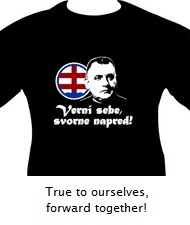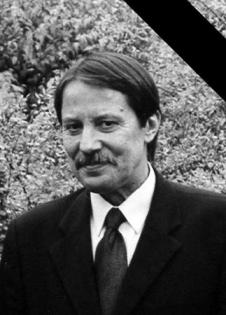Timely eviction of the Slovak National Memory Institute (2007)
The Slovak archive that could have shed light on Vatican collaboration with both the wartime Fascists and the postwar Communists was evicted, suffered funding cuts and had files that were safely stored in Prague suddenly repatriated. This happened in early 2007 — right after Archbishop Wielgus in neighbouring Poland was forced to resign when records showed he'd been a Communist spy — and just before it was announced that records in Prague also implicated the Slovak Archbishop Ján Sokol.
 The National Memory Institute preserves documents from both the fascist and communist eras in Slovakia. Material from these archives could threaten attempts to depict the fascist leader as a martyr to the communists. [1] And material from the succeeding period has already implicated as communist collaborators the top clerics of all the country’s main religions, including Cardinal Archbishop Ján Sokol. However, on 3 January 2007, amid the rising tide of allegations of espionage that forced out the Polish Archbishop Wielgus, the Slovak archive was told to pack its bags, thus preventing anything similar from happening to the Slovak Archbishop Ján Sokol.
The National Memory Institute preserves documents from both the fascist and communist eras in Slovakia. Material from these archives could threaten attempts to depict the fascist leader as a martyr to the communists. [1] And material from the succeeding period has already implicated as communist collaborators the top clerics of all the country’s main religions, including Cardinal Archbishop Ján Sokol. However, on 3 January 2007, amid the rising tide of allegations of espionage that forced out the Polish Archbishop Wielgus, the Slovak archive was told to pack its bags, thus preventing anything similar from happening to the Slovak Archbishop Ján Sokol.
National Memory Institute holds secrets of the Tiso and the Communist eras
The countries of Eastern Europe have shown different degrees of willingness to confront their Communist past. In terms of barring former functionaries from public office, bringing them to court and opening up the records, Slovakia has been among the least enthusiastic and the last: the country only established an archive in preparation for joining the EU. [2] The Slovak National Memory Institute (ÚPN) was set up in 2003 (as part of the Justice Department) to preserve and grant access to documents from the beginning of the Second World War to the end of the Communist era. Thus it had the potential to shed embarrassing light on Vatican collaboration with both the wartime clero-fascists led by Fr. Tiso and the postwar Communists.
The wartime material in this archive could prove highly embarassing for the Church.
A priest was the country’s president. An avowedly Catholic party governed the country, seeking to mold it according to Catholic principles. Many priests served in the country’s legislature, which voted, as did all its legislator priests, to deport the country’s Jews to their deaths. The Slovakian clergy, like other clergy, were under the discipline of the Pope. He had absolute authority over them. He could have commanded them to desist from acting in ways that violated the Church’s doctrine and practices. Yet he did not command them not to deport their country’s Jews to their deaths. [3]
The Catholic Church, the most powerful instution in Slovakia, had too much to lose if the historical record were examined impartially and from the very beginning the National Memory Institute ran into roadblocks. The man chosen to head it was the respected former dissident, Jan Langos, “a fierce opponent of Communism and Fascism”. [4] However, in 2003 the recently appointed Langos complained of having difficulty getting documents from the present Slovak Intelligence Service (SIS) [5], which "Jane's Intelligence Digest" claims is riddled with former members of Communist StB. [6]
 Even so, from late 2004 until early 2005 the archive regularly released the names of some 10,000 alleged collaborators with the Communist secret police, the StB. Included in the last batch, in March 2005, was the name of Archbishop Cardinal Ján Sokol. This is the cleric whose praise for the wartime Fascist regime and its leader, Msgr. Tiso, led to protests by Jews, a group that Tiso handed over to meet their fate in Nazi Germany. [7]
Even so, from late 2004 until early 2005 the archive regularly released the names of some 10,000 alleged collaborators with the Communist secret police, the StB. Included in the last batch, in March 2005, was the name of Archbishop Cardinal Ján Sokol. This is the cleric whose praise for the wartime Fascist regime and its leader, Msgr. Tiso, led to protests by Jews, a group that Tiso handed over to meet their fate in Nazi Germany. [7]
The compliity of many Slovak Catholic priest with a murderous regime did not end with the regime of Fr. Tiso, but continued during he Communist era.
In Slovakia the secret police's infiltration of the hierarchy appears to have been more thorough than elsewhere because the (Roman) Catholic church was vulnerable after allowing itself to become identified with the wartime Nazi puppet state led by priest Jozef Tiso. According to files released by the National Memory Institute, the bishops stayed loyal to the regime even as Communism was starting to crumble in 1988. [8]
The records have led former dissidents in the Church to call for the resignation of bishops who spied for the Communist regime and for an independent commission to investigate the Church's involvement with the StB. However, nothing has come of that.
While there are surviving documents listing Archbishop Sokol as an agent, the detailed ones are gone. In December 1989, when Communism collapsed, Sokol's personal ŠtB file was shredded. The National Memory Insititute is in theory capable of reconstructing the shredded files of agents from documents filed by other agents. This would give them the details of the Archbishop’s espionage, but in Sokol's case this has not been done. [9]
In June 2006 the National Memory Insititute and, it could be argued, Slovak democracy, suffered a blow when the Insitute’s chairman, Ján Langos, was killed in a traffic accident. Soon thereafter, in early August, an application was made in the name of the National Memory Institute to move files from safekeeping under the Czechs in Prague to Bratislava. A few weeks after that, former Slovak prime minister Vladimír Mečiar advised against appointing a successor for Langos: "I'm convinced that this Institute has already completed its historical role," said Mečiar, adding that he would include the Institute under the Slovak Academy of Sciences and reduce its budget. [10] Since then files of some prominent political figures have gone missing. [11]
While the Institute was being steadily weakened, Archbishop Sokol remained adamant. Despite the surviving documents listing him as an agent, Sokol has denied everything: "I just signed a small paper in 1988 saying that I will fulfil my duties as a priest and a bishop. That is all." In fact, the Archbishop went on to take the offensive, claiming that: "This is an attack on the Catholic Church". [12]
At the beginning of 2007 events in Poland put added pressure on the National Memory Institute, which was still without a chairman. Even Poland had been more open than Slovakia in investigating its Communist past, and there the archival material had led to charges that 10-15% of the Catholic hierarchy had been collaborators. Among those implicated was Archbishop-elect Stanislaw Wielgus. In the face of the gathering protest, the Vatican kept issuing denials and went ahead with plans to install him as Poland’s top primate. Finally, after he had already been consecrated, and as the ceremony was about to begin, the Polish Archbishop’s installation had to be called off. [13]
 However, no chance was given for this to spread to Slovakia. On 3 January 2007, four days before the consecration of the ill-fated Polish archbishop the Slovak Government made a move that precluded any awkward Polish-type revelations. Without warning or consultation, the Slovak Ministry of Justice gave the National Memory Institute six months to vacate the premises, claiming simply that they needed more court rooms. [14] And not a moment too soon, for early in February, documents were discovered in government archives in Prague, suggesting a relationship between Archbishop Sokol and the secret police of Czechoslovakia. [15]
However, no chance was given for this to spread to Slovakia. On 3 January 2007, four days before the consecration of the ill-fated Polish archbishop the Slovak Government made a move that precluded any awkward Polish-type revelations. Without warning or consultation, the Slovak Ministry of Justice gave the National Memory Institute six months to vacate the premises, claiming simply that they needed more court rooms. [14] And not a moment too soon, for early in February, documents were discovered in government archives in Prague, suggesting a relationship between Archbishop Sokol and the secret police of Czechoslovakia. [15]
No embarrassing leaks about Church collaboration with the Communists can be expected any time soon from the Slovak archives. The historians are too busy packing up.
Yet, precisely because of the political obstacles it faces, the work of the beleaguered National Memory Institute has become even more necessary. A Slovak editor said of its founder, Ján Langos: "He knew that if this country should exist as a decent society it has to know its past." [16]
Related
For more on the Church's troubled relationship with the historical record see:
♦ Pope’s claim to temporal power based on 8th-c forgery
♦ The Vatican and the Holocaust: A Preliminary Report International Catholic-Jewish Historical Commission (2000)
♦ Secret archives at the Vatican and in each diocese worldwide
Notes
1. Michael J Kopanic Jr, “The Legacy: The Tiso plaque controversy”, Central Europe Review, Vol 2, No 11, 20 March 2000. http://www.ce-review.org/00/11/kopanic11.html
2. Lavinia Stan, “The Politics of Memory in Post-Communist Europe: A Comparative Analysis”, Colloque « Expériences et mémoire : partager en français la diversité du monde » Bucarest, September 2006, pp. 2, 9. http://www.celat.ulaval.ca/histoire.memoire/b2006/Stan.pdf
3. Daniel Jonah Goldhagen, Hitler’s Willing Executioners (1997), quoted by Anthony J. Sciolino in his blog post, "Slovakia and the Holocaust", 10 March 2013 http://theholocaustandchurch.com/slovakia-holocaust/ Judge and Deacon Sciolino, a devout Roman Catholic, "began research for his book hoping to discover that the Catholic Church, and Holocaust-era Pope Pius XII, could be exonerated". http://theholocaustandchurch.com/reviews/ Instead, what he discovered shocked him, a reaction that closely parallels that of the Catholic scholar, John Cornwell, author of Hitler's Pope.
4. Axis Information and Analysis (AIA), 28 September 2006 http://www.axisglobe.com/news.asp?news=9284
5. “[46] Slovak Memory Institute says SIS stonewalling over StB files”, Radio Free Europe/Radio Liberty, 4 September 2003. http://www.hri.org/news/balkans/rferl/2003/03-08-04.rferl.html
6. “[45]'Jane's Intelligence' renews criticism of Slovak intelligence service”, Radio Free Europe/Radio Liberty, 4 September 2003. http://www.hri.org/news/balkans/rferl/2003/03-08-04.rferl.html
7. “Slovak Jews protest efforts to glorify pre-WWII nationalist leader”, Associated Press, 3 October 2007. http://www.iht.com/articles/ap/2007/10/03/europe/EU-GEN-Slovakia-Jews.php
8. Robert Anderson and Michal Simeck, “Files force Slovakia's churches to face past”, Financial Times, 28 March 2005. http://www.kirchen-in-osteuropa.de/archiv/05033103.htm#4
9. Martina Jurinová, “Archbishop denies having served as Communist spy”, Slovak Spectator, 22 January 2007. http://www.slovakspectator.sk/clanok.asp?cl=26317
10. “Meciar says we do not need National Memory Institute”, Slovak Radio International, 25 September 2006. http://www.slovakradio.sk/inetportal/rsi/core.php?lang=2
11. Luba Lesná, “Nation's Memory Institute to get new boss in February 1 vote:
ÚPN: Ján Langoš did not lose Široký file”, Slovak Spectator, 29 January 2007. http://www.slovakspectator.sk/clanok-26423.html
12. Robert Anderson and Michal Simeck, ibid.
13. Craig S. Smith, “New Warsaw archbishop quits over Communist collaboration”, New York Times, 8 January 2007. http://www.nytimes.com/2007/01/08/world/europe/08poland.html
“Warsaw Archbishop Quits Over Secret Police Past”, Spiegel, 8 January 2007. http://www.spiegel.de/international/acts-of-contrition-warsaw-archbishop-quits-over-secret-police-past-a-458280.html
14. “National Memory Institute evicted by Justice Ministry”, Slovak Spectator, 4 January 2007. http://www.slovakspectator.sk/clanok?cl=26170
15. Slovakia: archbishop denies acting as Communist informer, Catholic World News, 1 March 2007. http://www.catholicculture.org/news/features/index.cfm?recnum=49581
16. Andrea Dudikova, “Jan Langos, 59; Slovak dissident opened spy files”, Boston Globe, 18 June 2006. http://www.boston.com/news/globe/obituaries/articles/2006/06/18/jan_langos_59_slovak_dissident_opened_spy_files/







 Church and state in Slovakia
Church and state in Slovakia